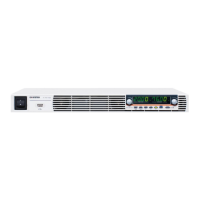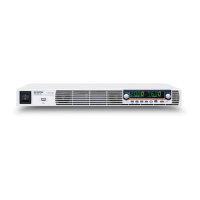Do you have a question about the GW Instek PSU 100-15 and is the answer not in the manual?
Describes the meaning of various safety symbols used in the manual and on the instrument.
Provides essential safety guidelines for operating and handling the PSU to prevent damage or injury.
Details safety instructions for using the power cord specifically in the United Kingdom.
Provides an overview of the PSU series, including model lineup and key specifications.
Highlights the key performance, features, and interface capabilities of the PSU series.
Lists standard and optional accessories included with the PSU unit for various applications.
Details the components and layout of the PSU series front panel for user interaction.
Explains the PSU display area, meters, and status LEDs for monitoring operation.
Describes the various connectors and ports available on the rear panel of the PSU.
Explains the fundamental principles, operating modes, and protection mechanisms of the PSU.
Details the Constant Current (CC) and Constant Voltage (CV) operating modes and their crossover points.
Describes how to adjust voltage/current slew rates for controlled output transitions.
Explains the function of the bleeder resistor for dissipating stored energy in filter capacitors.
Details how to simulate power sources by setting internal resistance values.
Lists and explains various alarm conditions and protection features like OVP, OCP, and UVL.
Covers essential setup steps including line voltage connection and initial power-up.
Guides on fundamental operations like setting protection levels and priority modes.
Explains how to connect and operate multiple PSUs in parallel or series configurations.
Details how to use the Test function for running, loading, and saving automated tests.
Covers adjustments for output delay times and slew rate selections for V-I modes.
Configures settings for USB and GPIB remote interfaces for communication.
Details the configuration of LAN settings, including IP address and DHCP.
Defines settings that are applied and configured during the power-up sequence.
Introduces analog control options for voltage/current output using external signals.
Provides pin assignments and descriptions for the analog remote control connector.
Explains how to control output voltage using an external voltage source.
Details controlling output voltage via an external resistance.
Describes how to monitor output voltage, current, and operation status remotely.
Covers specifications and usage of isolated analog interfaces for control and monitoring.
Provides guidance on configuring USB, GPIB, UART, and Ethernet interfaces.
Details the configuration steps for UART communication using RS232/RS485.
Explains how to connect and control multiple PSU units using Legacy Multi-Drop or Multi-Drop modes.
Covers configuring the Ethernet interface for remote control via web server or socket server.
Lists the default configuration settings for all PSU parameters.
Provides a reference for error messages and normal operational messages displayed.
Detailed technical specifications for PSU output, modes, protection, and performance.
| Model | PSU 100-15 |
|---|---|
| Category | Power Supply |
| Voltage Resolution | 10 mV |
| Current Resolution | 1 mA |
| Current Accuracy | ±0.1% + 10mA |
| Ripple and Noise (CV) | <= 2mVrms |
| Ripple and Noise (CC) | ≤3mArms |
| Display | LCD |
| Interface | RS232, USB |
| Operating Temperature | 0°C to 40°C |
| Storage Temperature | -20°C to 70°C |











